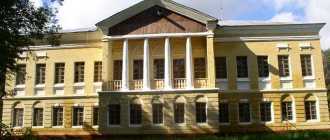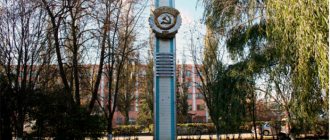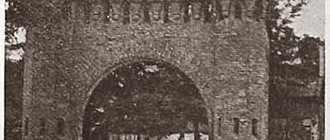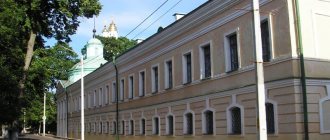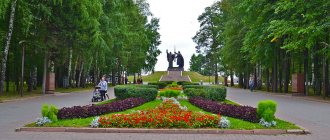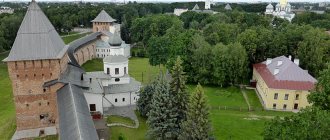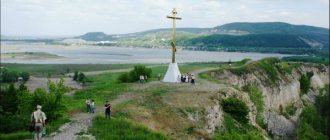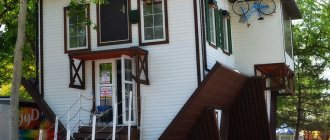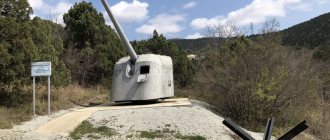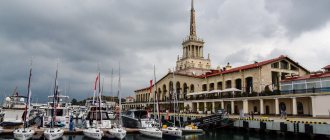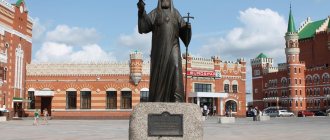Pereslavl-Zalessky is a rare example of a city that has survived from the 12th century. There are fourteen such cities in Russia (among them Moscow, Tver, Tula, Velikiye Luki, Volokolamsk). It was founded as a border protection settlement by Prince Yuri Dolgoruky and became the birthplace of the famous Alexander Nevsky.
It has preserved on its territory the remains of fortifications and earthworks of the 12th century, temples and monasteries founded in the 11th-17th centuries, unique places of worship of the ancient pagan Slavs. This makes it a place of pilgrimage for both Orthodox Christians and neo-pagans.
To make your trip more interesting, see what important places in the region you can visit on the way to and around Myshkin.
The city is part of the Golden Ring of Russia; about three hundred thousand people visit it every year, a considerable number of which are foreigners.
Other nearby cities of the Golden Ring, the visits of which can be conveniently planned with a trip to Pereslavl-Zalessky, are Sergiev Posad and Alexandrov. About all the cities of the ring, official and unofficial, in this list.
Lake Pleshcheyevo
Pereslavl-Zalessky stands on the shore of Lake Pleshcheyevo, which is almost perfectly round and looks like an overturned saucer from a height. The lake is thirty thousand years old, it is a trace left by a glacier traveling through ancient lands.
The age of the lake and its location allowed it to grow and preserve in its depths some endemic species, for example, the Pereslavl vendace and the relict marsh turtle.
The famous vendace is now listed in the Red Book, but, unfortunately, in shops in Pereslavl it can be found in smoked and salted form, albeit at an incredible price.
The size of the lake and the convenience of its sloping coastline in the 17th century prompted Peter the Great to think that it would become an excellent training ground for his Amusement Fleet.
At the moment, there are no shipyards or piers on the shores of the beautiful light lake. Many resorts and recreation centers offer water activities: kitesurfing in summer and snowkiting in winter.
The shores of the lake are sparsely built up, and you can simply walk along it, sit by the water, watching the waves splashing here since the times when there was not a trace of man on the Pereslavl land.
How to get there
Moscow — Pereslavl
There are a great many bus routes from Moscow to Pereslavl-Zalessky, but the travel time varies greatly: from 2 to 5 hours, depending on the number of bus stops. See the schedule here
UPD-2021. Russian Railways has opened a new railway route: a train from Moscow (from Yaroslavsky station) to Pereslavl-Zalessky. She also stops in Berendeyev. The only thing is that this route only operates on weekends and holidays. You will spend two hours on the road. The train leaves Moscow in the morning at 7.45, and departs back to Moscow at 18.30, so it’s very convenient to go “in one day”. The advantage is speed and comfort.
Yaroslavl — Pereslavl
There are a lot of direct bus services from Yaroslavl (several times every hour), the travel time is one and a half hours. Schedule here
Rostov — Pereslavl
There are also many flights from Rostov to Pereslavl, the journey takes from 1 hour, depending on the number of stops. Bus schedule here
Sergiev Posad — Pereslavl
Buses between Sergiev Posad and Pereslavl run twice a day, it is important not to be late! Travel time is an hour and a half, see the schedule here .
Kostroma — Pereslavl
You can get to Pereslavl by bus from Kostroma in 4 hours: schedule .
Museum-estate "Boat of Peter the Great"
Address: Pereslavl district, Veskovo village Telephone: (48535) 6-21-16 Website: https://www.museumpereslavl.ru/ Opening hours: from May to September from 10.00. until 18.00, the ticket office is open until 17.30 from October to May from 10.00. until 17.00, the ticket office is open until 16.30. day off - Monday. Cost: students under 16 years old - 100 rubles, pensioners and students - 150 rubles, adults - 200 rubles.
This is the oldest Russian provincial museum. It was founded in the 19th century. The main exhibit of the museum is the boat "Fortune", the only surviving witness to the ceremonial salvo in honor of the birth of the Russian fleet in the 17th century.
The conditions and care with which the boat was kept suggest that it was built personally by Peter the Great, and its name says the same thing: the great tsar respected capricious fortune and believed in it.
The museum-estate now includes:
- White Palace;
- Gatehouse;
- Rotunda;
- Triumphal Gate;
- Monument to Peter the Great;
- Obelisk to Peter the Great;
- Botny house.
On the territory of the museum-estate there is an interesting themed restaurant with the same name as the museum. The restaurant's interior is designed in the style of the hold of an old ship.
Blue stone
Address: Kriushkino village How to get there: along Kooperativnaya street (Nikitskaya Sloboda) along the shore of the lake 5 km to the village.
The legendary stone, a stone whose history is associated with many mystical secrets, continues to amaze people even now. Most likely, it arrived on Pereslavl land with a glacier and since then lay peacefully in a ravine until the ninth century, when its unusual color (and the stone, when wet in the rain, turns blue) and huge size (the weight of the stone is about 12 tons) attracted attention of the pagans. The stone became the center of rites and rituals dedicated to the spirit living in it, and since then it has seemed to come to life.
At the beginning of the seventeenth century, the monks of the Borisoglebsky Nadozerny Monastery, concerned that the pagans continued to organize games and dances around the stone, buried it, but already in the eighteenth century the stone came out again due to soil erosion.
Then they decided to attach it to a holy cause and lay it in the foundation of the Spiritual Church under construction, but during winter transportation across Lake Pleshcheyevo, the heavy stone went under the ice and hid at a depth of about three meters, only to appear on the shore again seventy years later.
Now the stone lies in the same place where it was washed up then. People come to the spirit of the Blue Stone with gifts and offerings: kvass, bread, grain. It is believed that all wishes made at the stone come true. This attention does not benefit the stone: pieces break off from it, its surface is contaminated with soggy bread.
There is a silent, friendly feeling of support from it, but apparently the stone is tired: for unknown reasons that even geologists cannot explain, it sinks into the ground. Its height is now just above the knee, but some twelve years ago it was more than one and a half meters high.
Visit the Blue Stone before it is completely hidden from human eyes. An incredible power emanates from the stone, which is felt by anyone who approaches it with respect.
Where to go
Pereslavl-Zalessky is conveniently located in terms of developing different travel routes around Russia.
On North
Rostov - Yaroslavl - Vologda - Kargopol along the way
Download route maps for the cities of the Golden Ring
Along the small ring
Or go along the small Golden Ring: Moscow - Sergiev Posad - Pereslavl-Zalessky - Rostov - Borisoglebsky - Kalyazin - Tver - Moscow. You can also expand such a circular route and add Yaroslavl, Tutaev, Rybinsk , Myshkin and Uglich .
Follow the links to see what to see in these cities and have a good trip! And with my developed routes along the Golden Ring, driving is much more pleasant - and you won’t miss anything.
All Golden Circle with 4trek guides
Select a city and follow the links
Vladimir Bogolyubovo and Pokrova-on-Nerl Suzdal Ivanovo Kostroma Yaroslavl Rostov Pereslavl-Zalessky Sergiev Posad Ples Privolzhsk Furmanov Borisoglebsky Kideksha Uglich Gus-Khrustalny Rybinsk Muromtsevo
Pereslavl Dendrological Garden named after. S.F. Kharitonov
Address: st. Zhuravleva, 1 Phone: (48535) 2-31-32 Website: https://www.botik.ru/park/dendrosad/ Opening hours: daily, 10.00 - 20.00, sale of entrance tickets until 19.00 Cost: 100 rubles.
A national dendrological park that you can return to many times: its territory covers as much as 58 hectares. There is a certain integrity in its diversity, woven from plants from dozens of countries: the park harmoniously combines compositions of trees, herbs and flowers brought from:
- China;
- Japan;
- North America;
- Europe;
- Crimea;
- Caucasus;
- Siberia.
The park's forbs and forests envelop you in aromas and green noise in the summer, delight with bright patterns of flowering, and in the fall they show the fiery splendor of extinction.
The park is decorated with wooden sculptures in the Russian style of an ancient wooden toy.
Goritsky Monastery
Address: Museum Lane, 4 Phone: (48535) 3-81-00 Website: https://museumpereslavl.ru/ Opening hours: from May to September: Tue-Sun 10.00 – 18.00. From October to April 10.00 – 17.00. Sanitary day is the last Tuesday of the month. In winter, the entrance to the bell tower is closed. Cost: https://www.museumpereslavl.ru/ru/visitor/price/
Founded in the 14th century under Ivan Kalita and lost its monastic significance in the eighteenth century. In the same century, the monastery lost its archives in a fire, and because of this loss, little historical reliable information about it remains.
The reasons for the abolition of the monastery also remain unknown: the huge complex, majestic and functional, could have fulfilled its role as a monastery for monks for many centuries, but for some reason it came into the possession of the Pereslavl bishop, turning into his estate. Perhaps ordinary human greed played a role in this matter.
The monastery remained an estate for no more than forty years, and then it began to overgrow, decay, and collapse... At the beginning of the twentieth century, it was completely littered with garbage and presented a sad spectacle of complete decline.
In 1919, it was saved by inclusion in the Pereslavl Museum-Reserve. On the territory of the monastery you will see:
- Assumption Cathedral (18th century);
- Bell tower and Church of the Epiphany (18th century);
- All Saints Church (17th century);
- Refectory Chamber (17th century);
- Church of St. Nicholas the Wonderworker (17th century);
- Column of the Church of Gethsemane (18th century);
- Holy gates, fortress walls and towers (17-18 centuries)
Pereslavl Kremlin
Address: Central part of the city, st. Soviet. Opening hours: around the clock Cost: free.
The Pereslavl Kremlin is still surrounded by high embankments and small ponds - the remains of former ditches and defensive structures. In the 12th century it was surrounded by wooden walls, and inside them there were princely mansions, outbuildings and the stone Transfiguration Cathedral, which you will see there even now.
The Kremlin was plundered by the Horde successively in the 13th, 14th, 15th centuries, after which it was carefully erected and fortified again by the inhabitants of Pereslavl. In the 16th century Sretensky Novodevichy Convent appeared on its territory.
The Kremlin is small, you can walk around it in half an hour. At the moment, only a few buildings remain from it, including walls: this is the Cathedral of the Vladimir Icon of the Mother of God, the Church of Alexander Nevsky.
Architecture and monuments of Pereslavl-Zalessky
A walk through the ancient city will bring the traveler many vivid impressions. There are interesting monuments on the streets of the city, and beautiful buildings can be found at almost every turn.
Monument to Alexander Nevsky
- Address: Red Square. Transport stop "LIT Plant".
The grand opening on Red Square of the city - the appanage estate of Alexander Nevsky, a monument to the most honorable citizen of not only the provincial Pereslavl-Zalessky or regional Yaroslavl , but also the whole country, took place in the winter of 1958. Then the townspeople - holders of the order bearing the name of the great commander, threw off the white veil from a bronze bust of the prince. Prince Alexander of Pereslavl is wise, favorable to his subjects, and harsh to his enemies. His brow is overshadowed by some special spirituality, characteristic only of truly great people - selfless defenders of the Faith and the Fatherland.
Rybnaya Sloboda
- Address: recreation in the southwestern part of the city. Transport stop "Ozero".
Rybnaya Sloboda is considered the most picturesque part of the city. It is interesting that since time immemorial this recreation was considered the personal property of the Grand Dukes of Moscow, who loved to feast on the local vendace. The architectural appearance of the area has been formed over centuries. Here you can still see ancient wooden mansions and admire the elegant Church of the Forty Martyrs. The surroundings of Rybnaya Sloboda have always inspired painters. Its plans can be seen on the canvases of D. Kardovsky, I. Komov, A. Tutunov, and other famous artists. Unfortunately, recently recreation has been losing its unique charm. However, there is still something to admire here, even despite active cottage construction.
Temerin estate
- Address: Krasny Lane, 10. Transport stop "Center".
The oldest among the surviving secular buildings of Pereslavl-Zalessky, it belonged to the family of successful merchants and manufacturers, the Temerins. The house is a fine example of a noble mansion in the classicist style, built at the end of the 18th century. Externally, the building is decorated very discreetly. The main decorations of the facade are rusticated masonry and a two-column portico, slightly set out beyond the main volume. In the interior of the mansion, however, one can find traces of the former well-being of the owners. Fragments of elegant stucco molding and a stove lined with tiles have been preserved here. Nowadays the building is occupied by the city military registration and enlistment office.
Monument to Yuri Dolgoruky
- Address: territory of the Goritsky monastery. Transport stop "Museum".
As you know, Grand Duke Yuri Dolgoruky is considered the founder of Pereslavl-Zalessky. Grateful townspeople have always respected the figure of the collector of Russian lands and cherished the hope of perpetuating his memory monumentally even in the Soviet era. In 1963, their dream came true. 810 years after the foundation of the Pereslavl fortress, which gave rise to the policy, a grand opening of a monument to the prince took place on the territory of the former Goritsky Monastery. Bust of Yuri Dolgoruky cast in bronze. It is a fragment of an equestrian statue of the Moscow ruler, installed on Tverskaya Square in the capital.
Zhitnikovs' mansion
- Address: st. Kardovskogo, 20. Transport stop “Sewing Factory”.
The architectural sights of Pereslavl-Zalessky also include a brick mansion that belonged to the merchant of the Second Guild N. Zhitnikov. The brick building with mezzanines, built in 1914, has two facades. The front porch, built in the shape of an oval projection, looks especially interesting. Once upon a time, the building was adjacent to verandas opening onto the manor's well-kept garden. The house was beautifully landscaped for the beginning of the last century. Its owners used bathrooms and bathrooms connected to city communications. The mansion had electric lighting and switching with a telephone exchange.
Nikitsky Monastery
Address: st. Zaprudnaya, 20, Nikitskaya Sloboda Phone: (48535) 3-20-08, 3-17-65 Opening hours: daily 7.00 – 20.00 Cost: free
The first church appeared on the site of the future monastery in 1010. Since then, its history has developed as follows: in the 16th century, Saint Daniel lived and worked here. In the seventeenth, the monastery was taken and burned by the Lithuanians; in memory of this event, two Lithuanian cannons can now be seen on the territory of the monastery.
In the eighteenth century, the monastery lost its main shrines: the chains and stone cap of St. Nikita were taken to Moscow. In the twentieth century, under Soviet rule, the monastery was plundered and handed over to secular authorities. A women's correctional labor colony was set up there.
Reconstruction and restoration began only in the late nineties of the twentieth century. Despite the difficult history, various architectural monuments and Orthodox shrines were erected on the territory of the monastery at different times and can now be seen.
Sixteenth century buildings:
- Fortress walls and towers
- Nikitsky Cathedral
Seventeenth century:
- Church of the Annunciation and refectory
- Tent bell tower
Eighteenth and nineteenth centuries:
- Pillar of Saint Nikita
- Monastic residential building
- Gate bell tower
- Chernigov Chapel
Sights of Pereslavl-Zalessky
Nikitsky Monastery in Pereslavl-Zalessky
The Nikitsky Monastery is located in the Yaroslavl region on the outskirts of the city of Pereslavl-Zalessky in the Nikitskaya Sloboda on the shore of Lake Pleshcheevo.
The monastery was founded at the beginning of the 10th century (according to other sources - a century later) to strengthen the Christian faith in pagan lands. There is information that Nikita of Pereslavl labored in this monastery, but information about the time of his stay in the monastery is contradictory. According to legend, he was a tax collector and often took advantage of his official position. But after a terrible vision he repented and for the rest of his life he wore heavy chains and a stone cap. In the 15th century, his relics were discovered and to this day are the main shrine of the monastery.
In the Middle Ages, the Nikitsky Monastery was in the favor of the kings, and they regularly donated money and lands to it. Initially, all the buildings of the monastery were wooden. The first stone structure, the Nikitsky Cathedral, appeared in 1528. Later, Ivan the Terrible ordered the construction of powerful walls and towers and the construction of a new solid fortified temple, which was done in 1561-1564. The old church became his chapel, dedicated to Nikita the Stylite. Nikitsky Cathedral can still be visited today. The temple is massive, five-domed, surrounded by a gallery. On the inside he is quite modest. the paintings on the walls have not survived.
In subsequent years, the first tsars from the Romanov family favored the monastery: Mikhail Romanov ordered the walls to be repaired, and Alexei Mikhailovich, in the middle of the 17th century, ordered the construction of the Annunciation Church, which still exists today.
There is evidence that Peter the Great spent some time in the Nikitsky Monastery: he stayed in the Refectory Chambers adjacent to the Church of the Annunciation.
Also, while examining the monastery, pay attention to the hipped bell tower adjacent to the refectory from 1668 and the gate bell tower, which is significantly different in style, since it was built much later - in the 19th century.
After the revolution in 1918, the property of the monastery was nationalized, and a few years later the monastery was closed. During the years of Soviet power, within the ancient walls there was a rest house, apartments, and a women's colony. In 1993, the monastery was returned to the Orthodox Church, its restoration began - it continues to this day. Currently, the monastery has come to life: several monks and novices work in it, and divine services are held daily. Many pilgrims come to it from all over Russia. There are especially many people on June 6 - the day of remembrance of St. Nikita.
First of all, Orthodox believers and people interested in medieval architecture should visit the Nikitsky Monastery. Other tourists, especially if they travel without a good guide, may be disappointed by the modest appearance of the monastery.
When visiting the Nikitsky Monastery, you must follow the rules: women must wear skirts, and their hair must be hidden under a headscarf. Both skirts and scarves can be rented - they are located at the gates of the monastery. Men, on the contrary, should not wear hats.
There is a brisk trade near the walls of the monastery on weekends: you can buy smoked fish, honey, and souvenirs.
Holy Trinity Danilov Monastery in Pereslavl-Zalessky
Holy Trinity Danilov Monastery is a men's monastery in Pereslavl-Zalessk. It was founded in 1508 by the Monk Daniil of Pereyaslavl on the site of the cemetery he created: during his life, the saint not only helped the sick and poor, but also collected on the roads the bodies of suddenly deceased people who had no one to bury, performed a funeral service for them and arranged a burial. Gradually, a group of like-minded people formed around him - the brethren of the new monastery.
According to legend, the father of Ivan the Terrible, Vasily III, turned to the saint for prayers for the birth of an heir, so Daniel became the godfather of the future tsar and in subsequent years, Russian rulers granted large sums to the monastery, with which in 1530-1532 they managed to build a stone four-pillar, single-domed Trinity Cathedral , which remains the main temple of this monastery today.
During the Time of Troubles, the monastery suffered greatly, but gradually regained its former possessions, and by the beginning of the 20th century it was a well-known prosperous monastery. But with the advent of the new government in 1923, it was decided to close the monastery. In subsequent years, a machine and tractor station was located within its walls, and during the Great Patriotic War - a camp for German prisoners of war.
In 1995, the monastery was rediscovered, and restoration work began.
Now it is a functioning monastery; divine services are held there daily. The main shrine of the monastery is the relics of St. Daniel of Pereyaslavl.
This monastery is worth visiting not only for pilgrims, but also for everyone interested in history, architecture and painting: fortunately, not only the buildings themselves have been preserved, but also the paintings on their walls; the unique frescoes of Gury Nikitin in the Trinity Cathedral deserve special attention. There are usually not many people in the monastery; mass tourists are not brought into it, so you can calmly admire the medieval paintings. However, the restoration of the monastery is ongoing, and therefore the entrance to some churches may be closed.
In addition to the Trinity Cathedral, in the Danilov Monastery you can see the small one-domed brick Church of All Saints with a vestibule, built in 1687. Inside, frescoes from the second half of the 17th century created by Kostroma painters have been preserved. And also pay attention to the Church of the Icon of the Mother of God of Tikhvin, built in 1700 in the Moscow Baroque style; and the single-domed Church of the Praise of the Blessed Virgin Mary on a high basement with a refectory, which served as a winter church.
When visiting this monastery, as well as other Orthodox places, you must not forget about the dress code: women should wear skirts and headscarves, men should wear decent, not too revealing clothes and have their heads uncovered.
Feodorovsky (Fedorovsky) Monastery in Pereslavl-Zalessky
The Fedorovsky (Feodorovsky) convent is the first to greet you if you enter Pereslavl-Zalessky from Moscow.
The monastery was founded in 1304 as a men's monastery during a period of internecine strife, on the site of a battle between the troops of Moscow Prince Yuri Danilovich and Tver Prince Mikhail Yaroslavich.
In 1667, Pereslavl suffered from a pestilence, and many women in the city became widows. Therefore, Tsar Alexei Mikhailovich ordered the disbandment of the small men’s monastery and the settlement there of single women who had taken monastic vows; from that time on, the monastery became a women’s monastery.
The walls of the monastery were built in 1681, when their defensive function was no longer important, so they do not have the usual loopholes and passages.
By the time of the revolution it was a rich monastery, in which 500 nuns lived. In 1923, the monastery was closed, the territory was given over to a children's colony, a nursing home, and in subsequent years other organizations were located there.
In the Fedorovsky Monastery you can see the five-domed temple of Fedor Stratilates: it was built in 1557 by order of Ivan the Terrible on the occasion of the birth of his son Fedor in the classical Old Russian style. Initially, the main church of the monastery looked different: at the beginning of the 18th century, a small bell tower was demolished, and at the end of the 19th century, a gallery was added to it on three sides.
Two more churches have survived to this day: the low refectory Vvedenskaya Church, built in 1710, and the modest Church of the Kazan Icon of the Mother of God, built in 1714. Also, cell buildings from the 17th-19th centuries, which were rebuilt several times, have reached us.
In 1998, the monastery buildings were returned to the church and restoration of the buildings began. Nowadays, several dozen nuns live in the monastery, and services are held regularly.
Nikolsky Monastery in Pereslavl-Zalessky
St. Nicholas Monastery was founded as a monastery during the Mongol-Tatar yoke around 1350 by the Monk Dmitry Prilutsky, a native of the village of Veslevo near Pereslavl-Zalessky. He took monastic vows at the nearby Goritsky Monastery and soon decided to found a monastery. It is known that St. Sergius of Radonezh visited the new monastery, who knew Dmitry Prilutsky well and supported him.
The following centuries were turbulent for the monastery: in 1382 the monastery and all of Pereslavl were burned by the troops of Khan Toktamysh, in 1408 the recreated monastery was ravaged by the troops of Emir Edigei. After this terrible invasion, the monastery was restored only in the second half of the 15th century. However, during the Time of Troubles, the monastery suffered greatly from the Poles and Lithuanians and was restored in 1613 thanks to the efforts of Elder Dionysius.
At the end of the 17th century, the main one, the St. Nicholas Cathedral, was founded and its main shrine, the Korsun Cross, was brought to the monastery, which is kept in the monastery to this day. Legend says that this is one of ten reliquary crosses that Prince Vladimir brought to Kyiv from Korsun (Chersonese).
At the end of the 19th century, the monastery fell into disrepair; only a few monks lived in it, so it was decided to transfer it to a larger female community, and the monastery became a women's monastery.
In 1923, the monastery, like many Russian monasteries, was closed, its main cathedral and bell tower were blown up, after which a livestock breeding base and a boarding school for children with special needs were opened in the remaining buildings.
In the 90s of the 20th century, the surviving buildings of the monastery were transferred to the church, after which a new St. Nicholas Cathedral was built on the site of the destroyed one, the architectural appearance of which was designed in the Old Russian style, not related to the destroyed one, which reflected the Baroque era, and a new belfry was erected.
Nowadays, in the monastery, in addition to the restored St. Nicholas Cathedral, where the Korsun Cross is now kept, you can see the preserved gate baroque Peter and Paul Church of the 18th century and the refectory Church of the Annunciation from 1748. The territory of the monastery is very well-groomed and in the summer it is surrounded by flowers. Restoration of ancient buildings continues.
The monastery is active, and services are held daily: on weekdays at 6:30 and at 17:00, on Sundays and holidays at 7:00 and at 17:00.
Do not forget that pilgrims and tourists visiting the monastery must follow the rules of Orthodox monasteries and wear decent clothing: women are required to wear skirts and scarves, men are required to have their heads uncovered.
Having arrived at this monastery, you can also examine the Smolensk-Kornilievskaya Church, standing next to its walls, which remains from the Boris and Gleb Monastery.
Lake Pleshcheyevo National Park
Lake Pleshcheyevo National Park is located in the south of the Yaroslavl region. It was created in 1988 to preserve the nature around Pereslavl-Zalessky and monitor the endemic population of the Pereslavl vendace fish.
The park includes the lake itself, its entire drainage basin and the vast territory around it: the Berendeyevskoe swamp, the Polovtsian-Kupan swamp complex and the city of Pereslavl-Zalessky. The flora of the park is represented by 790 species of plants (84 of them are very rare), the fauna is represented by about 500 species of animals.
Lake Pleshcheyevo is connected with the history of Russia; it is called the birthplace of the Russian fleet, because on its southern shore on Mount Gremyach in 1692, Peter the Great founded a shipyard for the construction of ships of the amusing flotilla, on which he later sailed on the lake and studied navigation.
On the shore of Lake Pleshcheevo in the reserve there is the Blue Stone - a pagan shrine that was worshiped by the Slavs who lived on the shore a thousand years ago.
Today Lake Pleshcheyevo is known as a picturesque place for relaxation, fishing (for perch, ruffes) and as a mecca for kite surfing and windsurfing, a place suitable for both beginners and experienced riders. Beginning athletes like that they can still stand a couple of hundred meters from the shore, while experienced ones are attracted by the open spaces (the size of the lake is 9 kilometers long and 9 kilometers wide) and the “correct” nervous winds. There is a surf station on the lake near the village of Gorodishche.
From November to April, Lake Pleshcheyevo is covered with ice. When it becomes strong, snowkiting enthusiasts ride on the lake.
You can swim in the lake: from about the beginning of June to mid-August, the water is quite comfortable and quite clean, although cool, but not everyone likes the viscous silt bottom.
There are hotels and mini-hotels around Lake Pleshcheevo, and you can also stay in a tent on the shore. Setting up tents is allowed near the water behind Nikitskaya Sloboda in the area of the village of Gorodishche and the village of Kriushkino. An environmental fee of 300 rubles is charged for parking, use of toilets and waste containers.
You will photograph the most beautiful views of the lake if you climb to the Alexandrov Mountain located on the shore near the village of Gorodishche or to the bell tower of the former Goritsky Monastery (which now houses the Pereslavl-Zalessky Museum-Reserve). The lake is also very beautiful if you look at it from the place where the Trubezh River flows into it, next to the Church of the Forty Martyrs.
Pereslavl-Zalessky Museum-Reserve (Goritsky Monastery)
The Pereslavl-Zalessky Museum-Reserve is located in the buildings of the abolished Goritsky Monastery.
This is the main museum of the city of Pereslavl, which all tourists are required to visit. The exhibitions are very diverse, you can buy a separate ticket for each, so you can choose exhibitions that are interesting to you, or just walk around the territory of the former monastery and look at the ancient buildings. The main exhibitions are located in the outbuildings of the former monastery: “Ancient Russian Art of the 15th-18th Centuries” - the basis of the collection consists of icons taken after the revolution from closed and destroyed churches and monasteries of the Pereslavl region, “Russian painting of the 18th-20th centuries” brings together paintings by artists Peredvizhniki, portraits that came to the museum in the 20s from the former manorial estates, “Wooden sculpture and carving of the 16th-19th centuries” and “The Art of the Russian Village” - traditional clothes and shoes, household items. You can also see the exhibition “The Beagle Sets Sail”, dedicated to the expedition of Charles Darwin, local history exhibitions “The Amazing World of Nature of the Zalessk Territory”, “Pereslavl 100 Years Ago”.
In the architectural monument of the 17th century - the Church of All Saints - there are exhibitions “The Silver Pantry”, which presents the treasures of the monastery sacristies of the 16th-19th centuries, and “Wreath to the Estates” - visitors can see interior items from noble estates.
The buildings of the former monastery are also noteworthy. First of all, it is worth visiting the Assumption Cathedral, built in the 18th century. It is surrounded from the north and south by covered galleries, and from the east by a semicircular apse. In past centuries, the unpreserved building of the so-called Gethsemane adjoined it. Inside you will see a luxurious baroque interior, richly decorated with stucco moldings and picturesque panels. The images for the iconostasis were created by painters from the New Jerusalem Monastery.
Note the large bell tower of the Church of the Epiphany above the eastern wall of the monastery. It was built intermittently throughout the 18th century, so it is noticeable that the lower and upper tiers are different. You can climb the bell tower: it offers a beautiful view of the city and Lake Pleshcheyevo.
Admire the Passage (Eastern) Gate, built in the middle of the 17th century: it amazes with the variety of architectural details and is richly decorated with patterns characteristic of that time. The superstructure over the gate appeared much later - in the 19th century.
Sorokosvyatsky Church
Address: st. Left Embankment, 165 Phone: (48535) 9-85-11 Opening hours: Saturday 7.00 – 20.00, Sunday and holidays 7.00 – 15.00 Cost: free
It is relatively young compared to the rest of the temples and churches of Pereslavl: it was founded in the 18th century. It attracts the attention of tourists going in search of true antiquities due to its difficult location for construction: the muddy shore of Lake Pleshcheevo. The church is reinforced with piles, rocky embankments and special bridges and thanks to them it has retained its appearance for two hundred and fifty years.
The five-domed church with a bell tower survived Soviet times by a miracle that is associated with its dedication. It is dedicated to forty Christian martyrs who were executed for refusing to join pagan games and idolatry.
Legend has it that it was the holy martyrs who protected the church from destruction and encroachment by Soviet power, just as they once protected their souls from the secular power of the Roman emperors.
The place is very beautiful: the view of the smooth lake and the silence surrounding the church, the invisible presence of its holy defenders leave an impression that is called “grace”.
Streets of Pereslavl
Pereslavl is small, but there are a lot of temples and monasteries visible from different parts of the city, so even a short walk will be enriched by the views.
You will be delighted by Rybnaya Sloboda : most of the paintings and drawings on boxes that are offered in Pereslavl as souvenirs depict landscapes of Rybnaya Sloboda. It is called “Russian Venice,” which does not really fit with its real name.
The areas of ancient streets and houses in the spirit of Russian architecture on the shores of the lake are becoming smaller and smaller due to the construction of modern cottages, so it is better to visit the settlement before it turns into an area of typical cottage development.
In Sokolskaya Sloboda you will find another monastery built in the 16th century: Holy Trinity Danilovsky . The monastery was erected in honor of the birth of Ivan the Terrible, and this dedication seemed to leave an imprint on the appearance of the monastery: severity, some architectural heaviness are reminiscent of the character of the famous Russian Tsar.
Going to Red Square, take a walk along the ancient earthen rampart : from there you can see the lake and the heads of the monasteries on the other side melting in the fog.
What to see in Pereslavl-Zalessky
Small Pereslavl played a major role in the history of Russia: it was founded in the middle of the 12th century by Yuri Dolgoruky, Alexander Nevsky was born in this city, Peter the Great founded the “amusing flotilla” on Lake Pleshcheyevo and thereby laid the foundation for the Russian fleet. Therefore, it is not surprising that in Pereslavl you can visit collections that tell in detail about different periods of Russian history - this is the Pereslavl-Zalessky Museum-Reserve, the Boat of Peter I. Also in the city there are several small interesting unusual private collections, such as the Iron Museum, the Museum of Tricks and Ingenuity , Radio Museum and others, where interesting interactive excursions are held.
Basically, all the attractions are located along the main highway that runs through the entire city, or not far from it: this is Moskovskaya Street, which then turns into Kardovsky Street, then into Sovetskaya, Rostovskaya and Uritsky. Bus No. 1 runs almost through the entire city along this street, the route of which starts at the bus station, which is very convenient: on it you can go around the main interesting places. The only significant museum that is located away from this route is the Boat of Peter I, located in the village of Veskovo. Many pilgrims come to Pereslavl. those seeking to visit the revived monasteries: Nikitsky, Danilovsky, Fedorovsky, Nikolsky.
Near Pereslavl there is a huge Lake Pleshcheyevo - a mecca for lovers of windsurfing and kiting.
